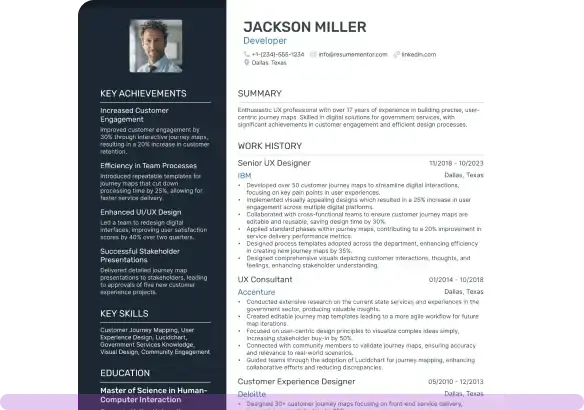Asset Protection Specialist Resume Examples

Mar 25, 2025
|
12 min read
Learn how to craft an asset protection specialist resume that showcases your skills in safeguarding assets. Uncover tips to fortify your credentials and ensure your career remains theft-proof with a well-protected portfolio.
Rated by 348 people
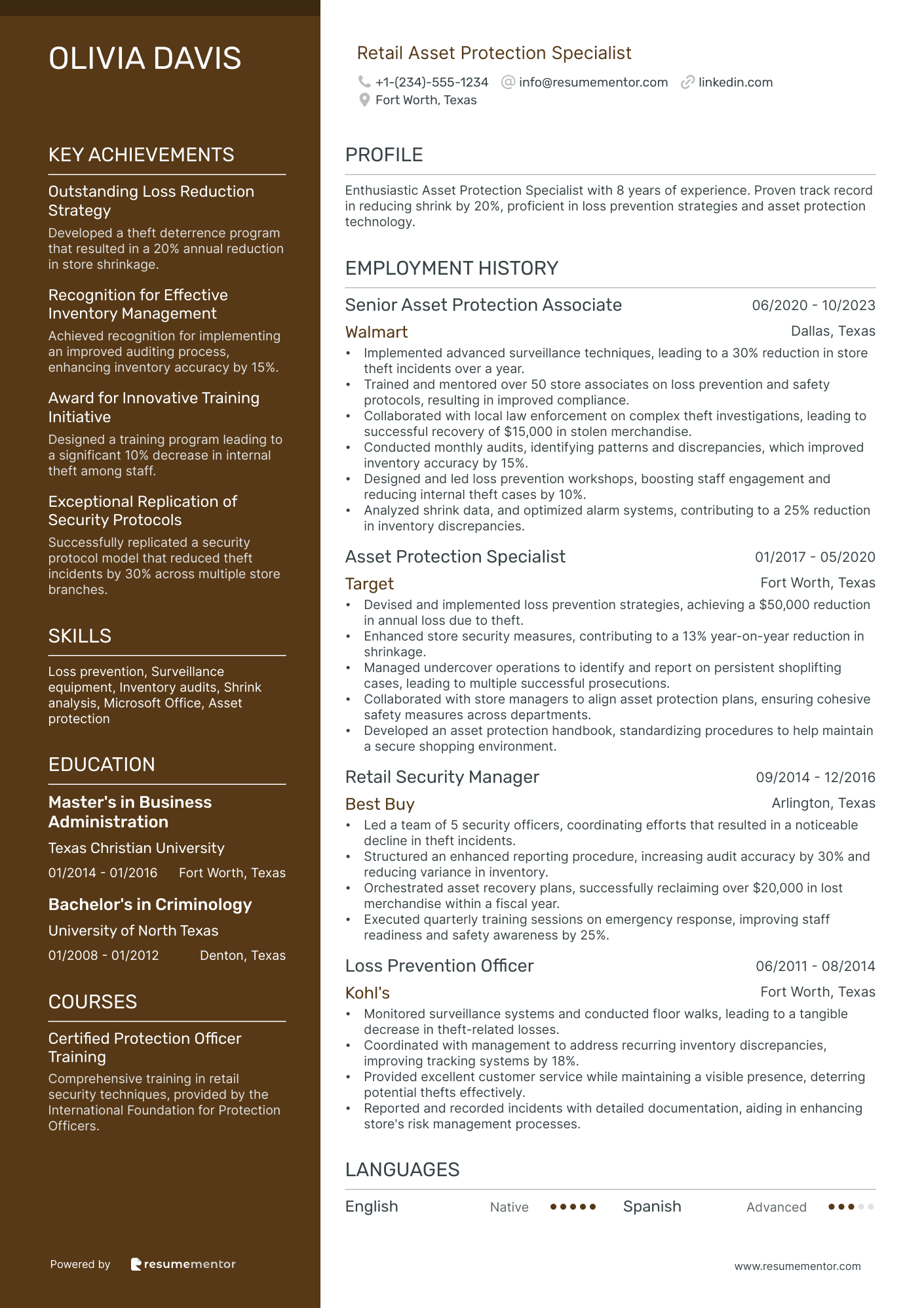
Retail Asset Protection Specialist
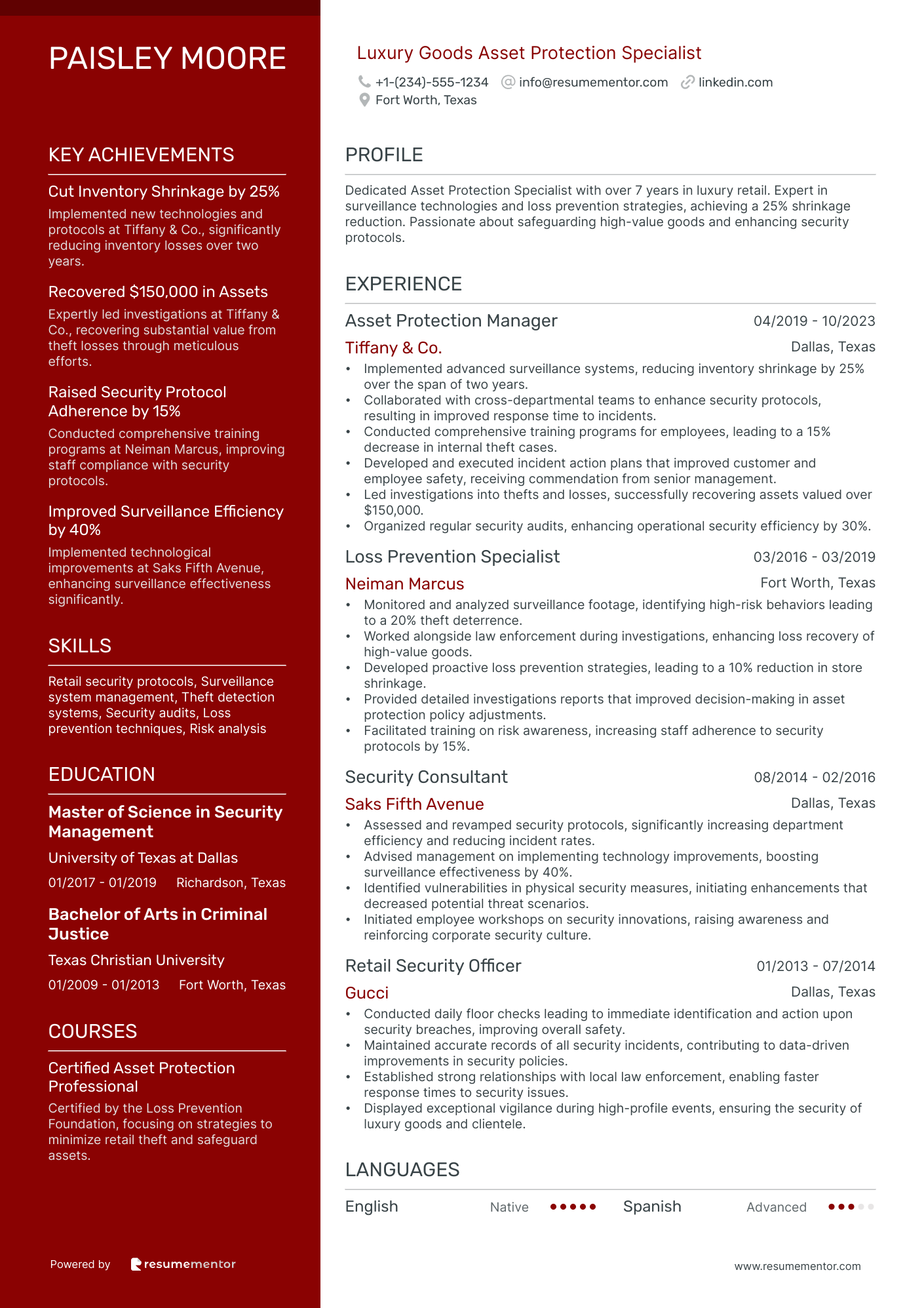
Luxury Goods Asset Protection Specialist
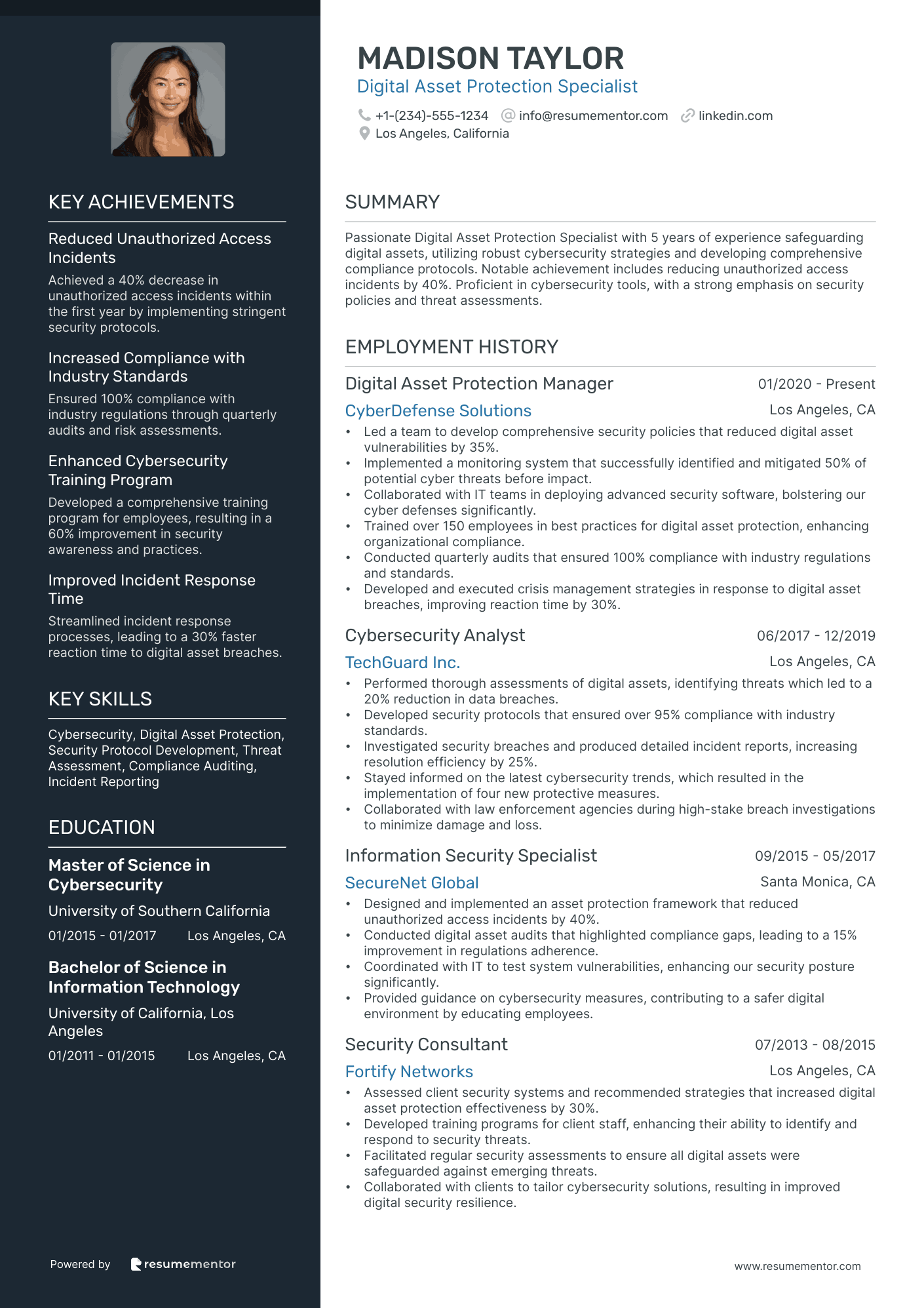
Digital Asset Protection Specialist
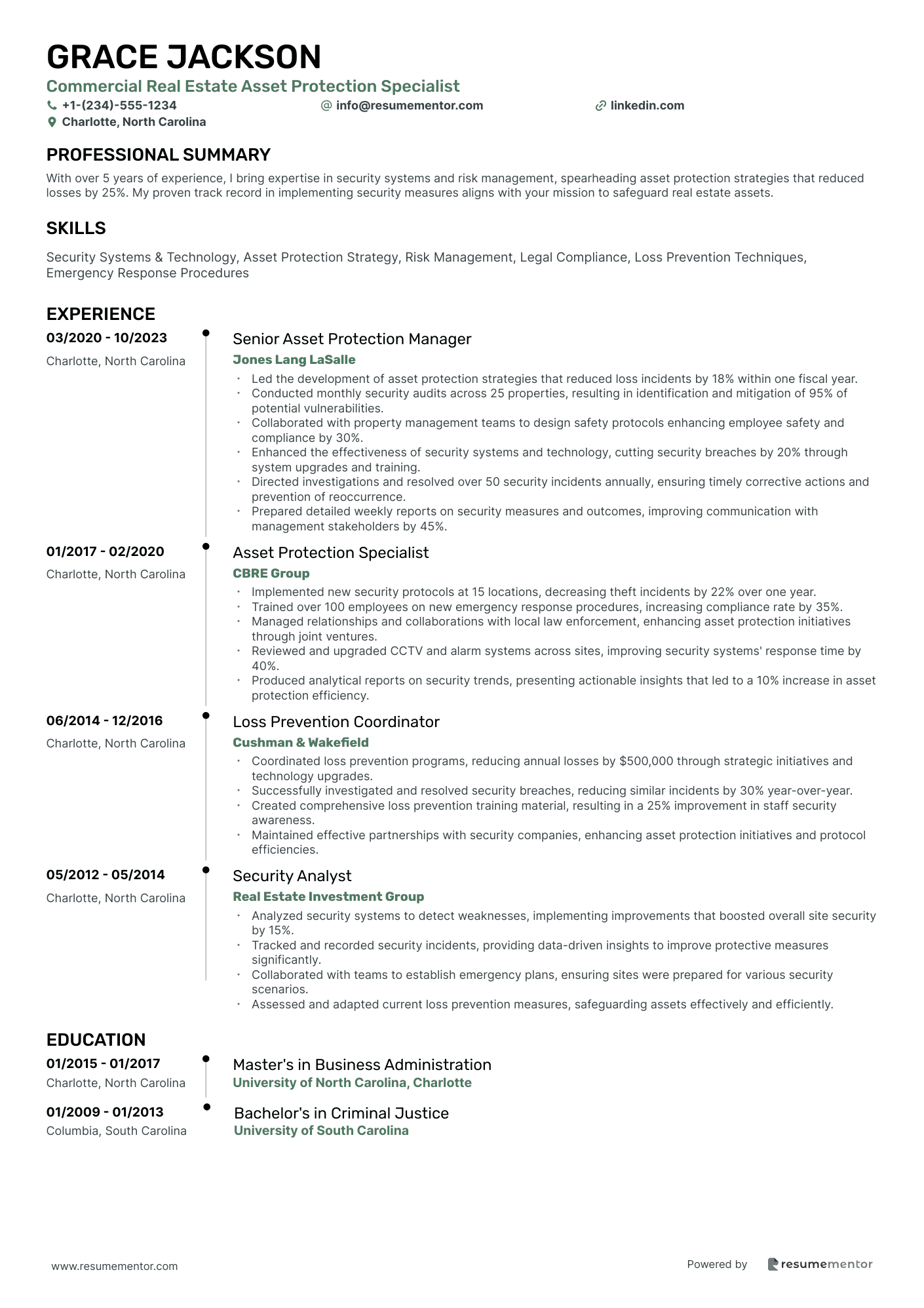
Commercial Real Estate Asset Protection Specialist
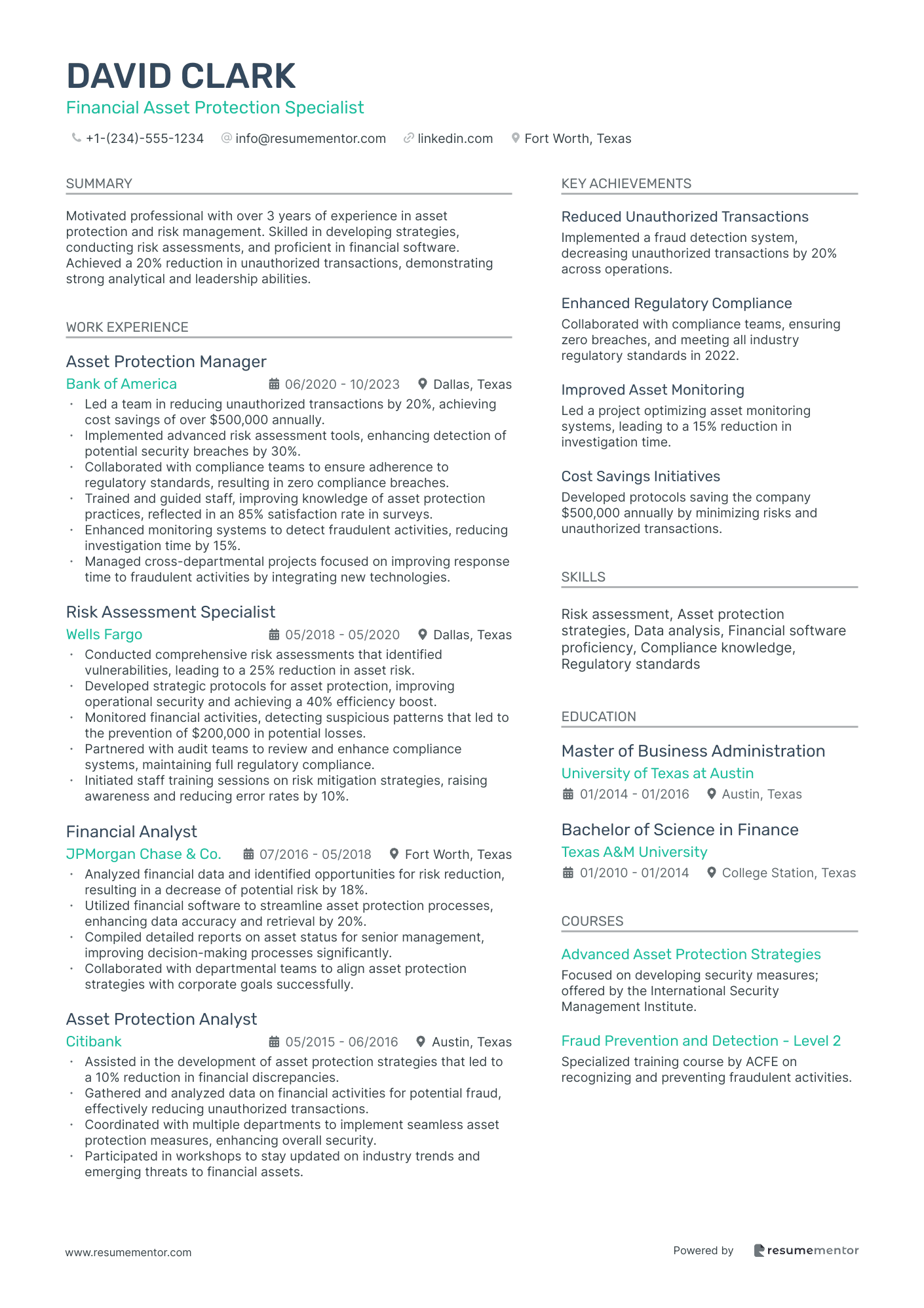
Financial Asset Protection Specialist
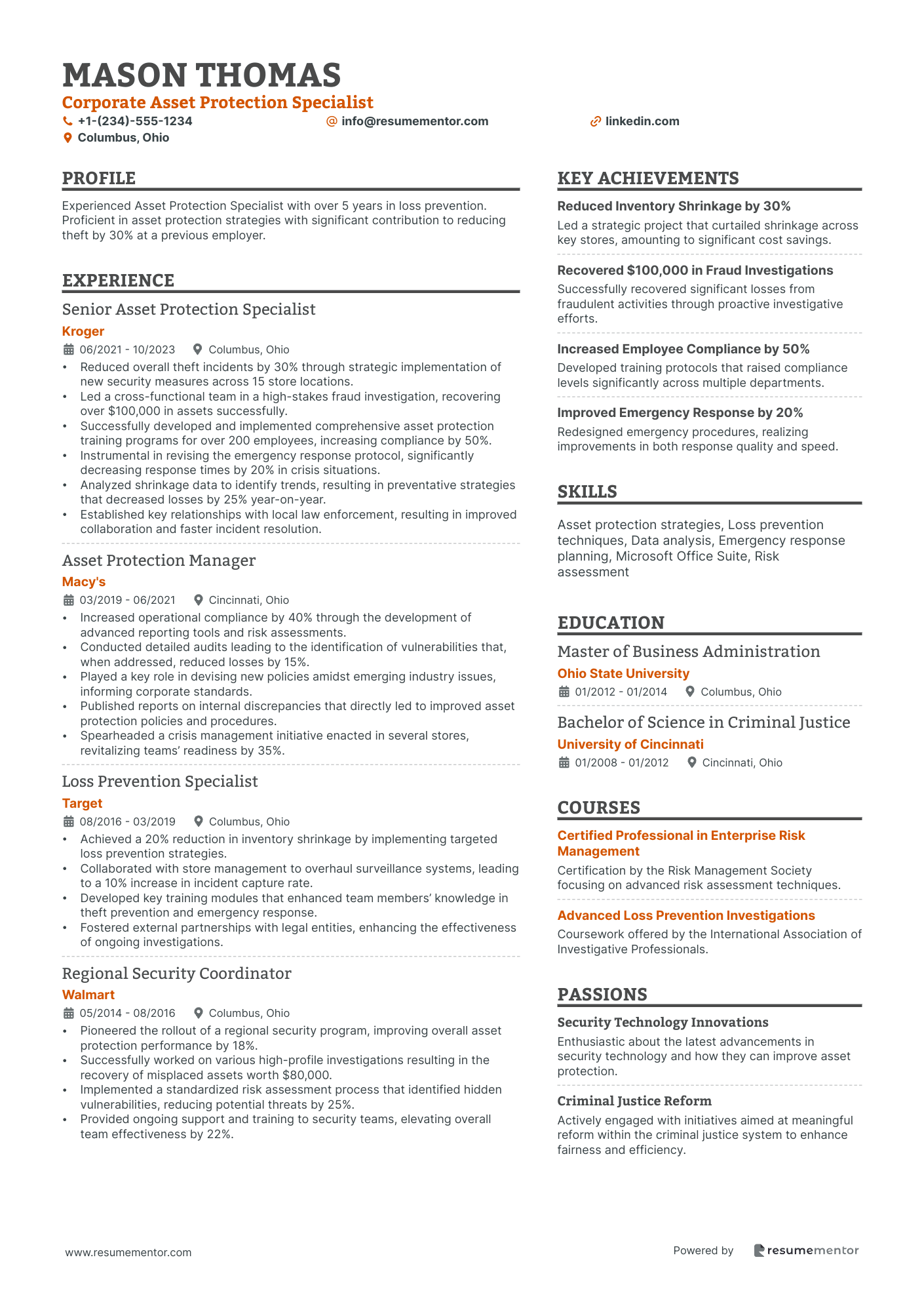
Corporate Asset Protection Specialist
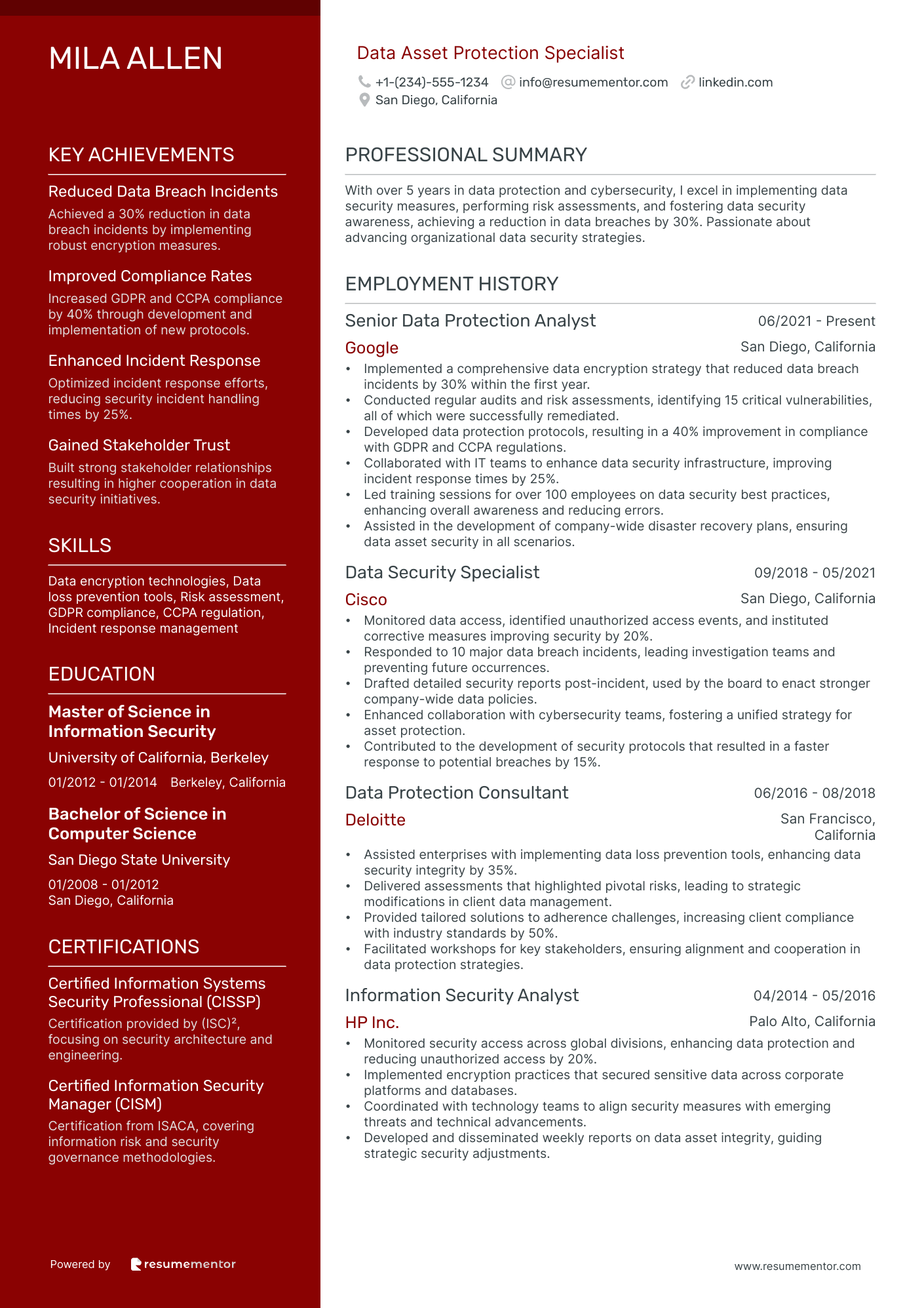
Data Asset Protection Specialist
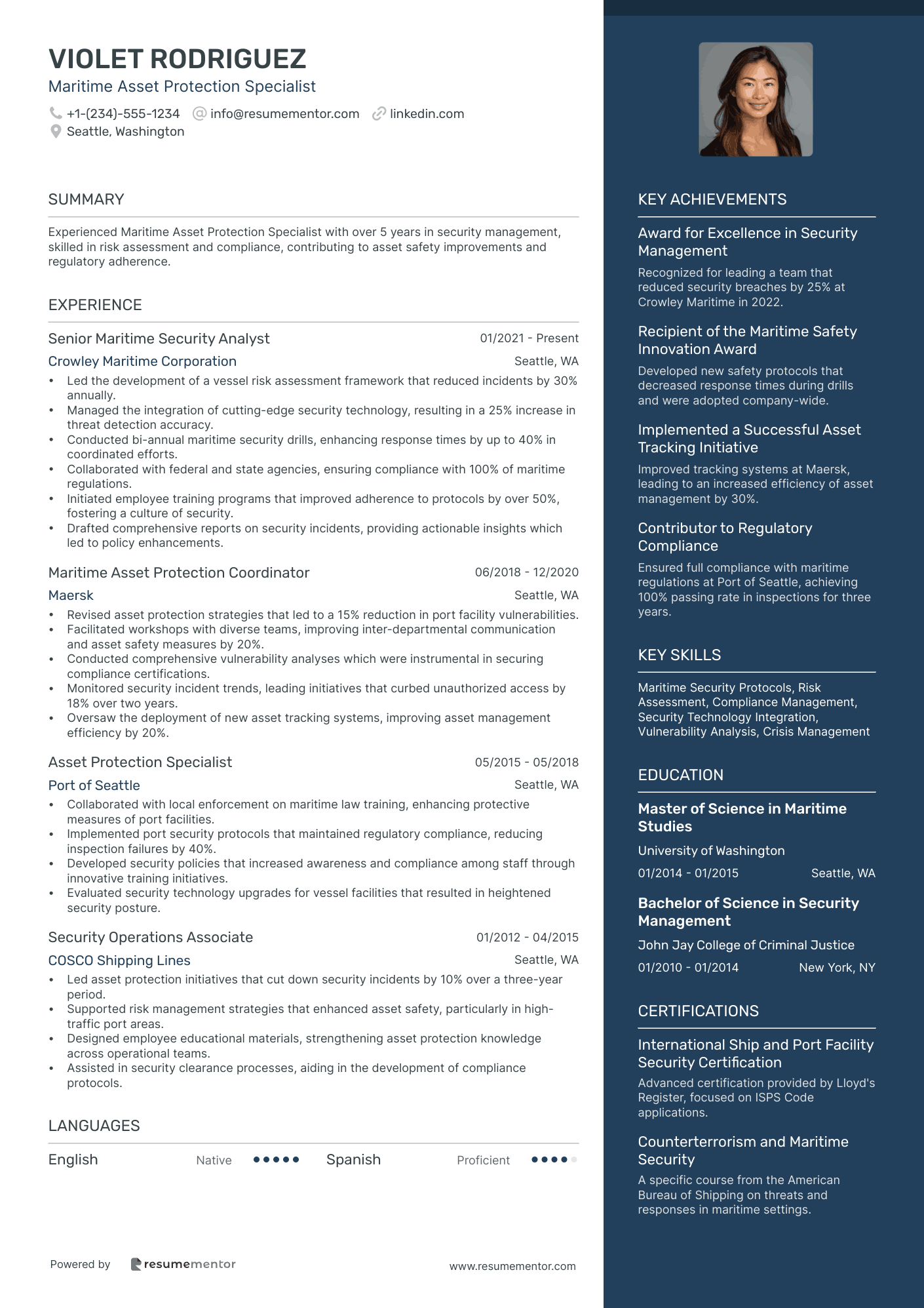
Maritime Asset Protection Specialist
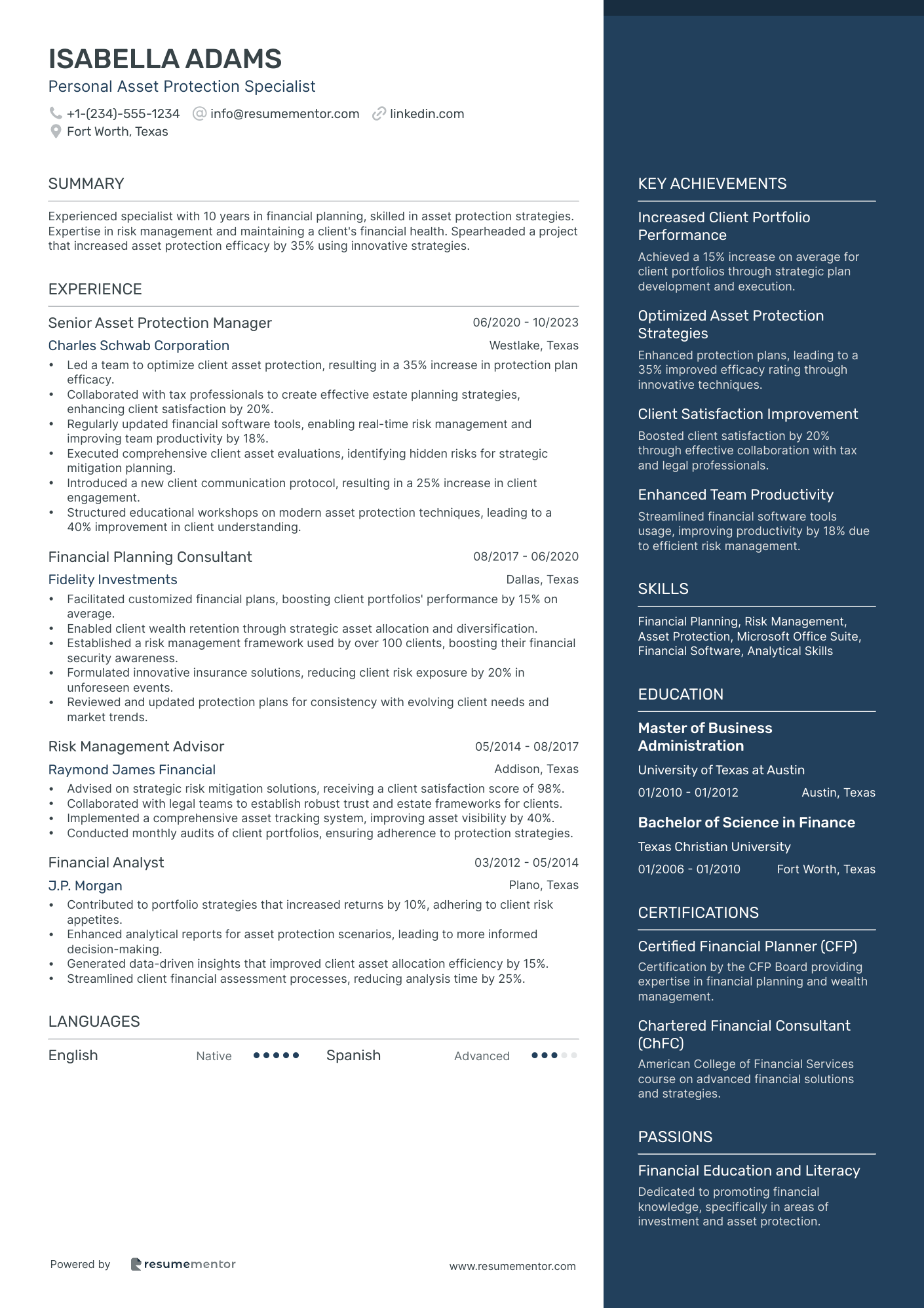
Personal Asset Protection Specialist

Inventory Asset Protection Specialist

Retail Asset Protection Specialist resume sample
- •Implemented advanced surveillance techniques, leading to a 30% reduction in store theft incidents over a year.
- •Trained and mentored over 50 store associates on loss prevention and safety protocols, resulting in improved compliance.
- •Collaborated with local law enforcement on complex theft investigations, leading to successful recovery of $15,000 in stolen merchandise.
- •Conducted monthly audits, identifying patterns and discrepancies, which improved inventory accuracy by 15%.
- •Designed and led loss prevention workshops, boosting staff engagement and reducing internal theft cases by 10%.
- •Analyzed shrink data, and optimized alarm systems, contributing to a 25% reduction in inventory discrepancies.
- •Devised and implemented loss prevention strategies, achieving a $50,000 reduction in annual loss due to theft.
- •Enhanced store security measures, contributing to a 13% year-on-year reduction in shrinkage.
- •Managed undercover operations to identify and report on persistent shoplifting cases, leading to multiple successful prosecutions.
- •Collaborated with store managers to align asset protection plans, ensuring cohesive safety measures across departments.
- •Developed an asset protection handbook, standardizing procedures to help maintain a secure shopping environment.
- •Led a team of 5 security officers, coordinating efforts that resulted in a noticeable decline in theft incidents.
- •Structured an enhanced reporting procedure, increasing audit accuracy by 30% and reducing variance in inventory.
- •Orchestrated asset recovery plans, successfully reclaiming over $20,000 in lost merchandise within a fiscal year.
- •Executed quarterly training sessions on emergency response, improving staff readiness and safety awareness by 25%.
- •Monitored surveillance systems and conducted floor walks, leading to a tangible decrease in theft-related losses.
- •Coordinated with management to address recurring inventory discrepancies, improving tracking systems by 18%.
- •Provided excellent customer service while maintaining a visible presence, deterring potential thefts effectively.
- •Reported and recorded incidents with detailed documentation, aiding in enhancing store's risk management processes.
Luxury Goods Asset Protection Specialist resume sample
- •Implemented advanced surveillance systems, reducing inventory shrinkage by 25% over the span of two years.
- •Collaborated with cross-departmental teams to enhance security protocols, resulting in improved response time to incidents.
- •Conducted comprehensive training programs for employees, leading to a 15% decrease in internal theft cases.
- •Developed and executed incident action plans that improved customer and employee safety, receiving commendation from senior management.
- •Led investigations into thefts and losses, successfully recovering assets valued over $150,000.
- •Organized regular security audits, enhancing operational security efficiency by 30%.
- •Monitored and analyzed surveillance footage, identifying high-risk behaviors leading to a 20% theft deterrence.
- •Worked alongside law enforcement during investigations, enhancing loss recovery of high-value goods.
- •Developed proactive loss prevention strategies, leading to a 10% reduction in store shrinkage.
- •Provided detailed investigations reports that improved decision-making in asset protection policy adjustments.
- •Facilitated training on risk awareness, increasing staff adherence to security protocols by 15%.
- •Assessed and revamped security protocols, significantly increasing department efficiency and reducing incident rates.
- •Advised management on implementing technology improvements, boosting surveillance effectiveness by 40%.
- •Identified vulnerabilities in physical security measures, initiating enhancements that decreased potential threat scenarios.
- •Initiated employee workshops on security innovations, raising awareness and reinforcing corporate security culture.
- •Conducted daily floor checks leading to immediate identification and action upon security breaches, improving overall safety.
- •Maintained accurate records of all security incidents, contributing to data-driven improvements in security policies.
- •Established strong relationships with local law enforcement, enabling faster response times to security issues.
- •Displayed exceptional vigilance during high-profile events, ensuring the security of luxury goods and clientele.
Digital Asset Protection Specialist resume sample
- •Led a team to develop comprehensive security policies that reduced digital asset vulnerabilities by 35%.
- •Implemented a monitoring system that successfully identified and mitigated 50% of potential cyber threats before impact.
- •Collaborated with IT teams in deploying advanced security software, bolstering our cyber defenses significantly.
- •Trained over 150 employees in best practices for digital asset protection, enhancing organizational compliance.
- •Conducted quarterly audits that ensured 100% compliance with industry regulations and standards.
- •Developed and executed crisis management strategies in response to digital asset breaches, improving reaction time by 30%.
- •Performed thorough assessments of digital assets, identifying threats which led to a 20% reduction in data breaches.
- •Developed security protocols that ensured over 95% compliance with industry standards.
- •Investigated security breaches and produced detailed incident reports, increasing resolution efficiency by 25%.
- •Stayed informed on the latest cybersecurity trends, which resulted in the implementation of four new protective measures.
- •Collaborated with law enforcement agencies during high-stake breach investigations to minimize damage and loss.
- •Designed and implemented an asset protection framework that reduced unauthorized access incidents by 40%.
- •Conducted digital asset audits that highlighted compliance gaps, leading to a 15% improvement in regulations adherence.
- •Coordinated with IT to test system vulnerabilities, enhancing our security posture significantly.
- •Provided guidance on cybersecurity measures, contributing to a safer digital environment by educating employees.
- •Assessed client security systems and recommended strategies that increased digital asset protection effectiveness by 30%.
- •Developed training programs for client staff, enhancing their ability to identify and respond to security threats.
- •Facilitated regular security assessments to ensure all digital assets were safeguarded against emerging threats.
- •Collaborated with clients to tailor cybersecurity solutions, resulting in improved digital security resilience.
Commercial Real Estate Asset Protection Specialist resume sample
- •Led the development of asset protection strategies that reduced loss incidents by 18% within one fiscal year.
- •Conducted monthly security audits across 25 properties, resulting in identification and mitigation of 95% of potential vulnerabilities.
- •Collaborated with property management teams to design safety protocols enhancing employee safety and compliance by 30%.
- •Enhanced the effectiveness of security systems and technology, cutting security breaches by 20% through system upgrades and training.
- •Directed investigations and resolved over 50 security incidents annually, ensuring timely corrective actions and prevention of reoccurrence.
- •Prepared detailed weekly reports on security measures and outcomes, improving communication with management stakeholders by 45%.
- •Implemented new security protocols at 15 locations, decreasing theft incidents by 22% over one year.
- •Trained over 100 employees on new emergency response procedures, increasing compliance rate by 35%.
- •Managed relationships and collaborations with local law enforcement, enhancing asset protection initiatives through joint ventures.
- •Reviewed and upgraded CCTV and alarm systems across sites, improving security systems' response time by 40%.
- •Produced analytical reports on security trends, presenting actionable insights that led to a 10% increase in asset protection efficiency.
- •Coordinated loss prevention programs, reducing annual losses by $500,000 through strategic initiatives and technology upgrades.
- •Successfully investigated and resolved security breaches, reducing similar incidents by 30% year-over-year.
- •Created comprehensive loss prevention training material, resulting in a 25% improvement in staff security awareness.
- •Maintained effective partnerships with security companies, enhancing asset protection initiatives and protocol efficiencies.
- •Analyzed security systems to detect weaknesses, implementing improvements that boosted overall site security by 15%.
- •Tracked and recorded security incidents, providing data-driven insights to improve protective measures significantly.
- •Collaborated with teams to establish emergency plans, ensuring sites were prepared for various security scenarios.
- •Assessed and adapted current loss prevention measures, safeguarding assets effectively and efficiently.
Financial Asset Protection Specialist resume sample
- •Led a team in reducing unauthorized transactions by 20%, achieving cost savings of over $500,000 annually.
- •Implemented advanced risk assessment tools, enhancing detection of potential security breaches by 30%.
- •Collaborated with compliance teams to ensure adherence to regulatory standards, resulting in zero compliance breaches.
- •Trained and guided staff, improving knowledge of asset protection practices, reflected in an 85% satisfaction rate in surveys.
- •Enhanced monitoring systems to detect fraudulent activities, reducing investigation time by 15%.
- •Managed cross-departmental projects focused on improving response time to fraudulent activities by integrating new technologies.
- •Conducted comprehensive risk assessments that identified vulnerabilities, leading to a 25% reduction in asset risk.
- •Developed strategic protocols for asset protection, improving operational security and achieving a 40% efficiency boost.
- •Monitored financial activities, detecting suspicious patterns that led to the prevention of $200,000 in potential losses.
- •Partnered with audit teams to review and enhance compliance systems, maintaining full regulatory compliance.
- •Initiated staff training sessions on risk mitigation strategies, raising awareness and reducing error rates by 10%.
- •Analyzed financial data and identified opportunities for risk reduction, resulting in a decrease of potential risk by 18%.
- •Utilized financial software to streamline asset protection processes, enhancing data accuracy and retrieval by 20%.
- •Compiled detailed reports on asset status for senior management, improving decision-making processes significantly.
- •Collaborated with departmental teams to align asset protection strategies with corporate goals successfully.
- •Assisted in the development of asset protection strategies that led to a 10% reduction in financial discrepancies.
- •Gathered and analyzed data on financial activities for potential fraud, effectively reducing unauthorized transactions.
- •Coordinated with multiple departments to implement seamless asset protection measures, enhancing overall security.
- •Participated in workshops to stay updated on industry trends and emerging threats to financial assets.
Corporate Asset Protection Specialist resume sample
- •Reduced overall theft incidents by 30% through strategic implementation of new security measures across 15 store locations.
- •Led a cross-functional team in a high-stakes fraud investigation, recovering over $100,000 in assets successfully.
- •Successfully developed and implemented comprehensive asset protection training programs for over 200 employees, increasing compliance by 50%.
- •Instrumental in revising the emergency response protocol, significantly decreasing response times by 20% in crisis situations.
- •Analyzed shrinkage data to identify trends, resulting in preventative strategies that decreased losses by 25% year-on-year.
- •Established key relationships with local law enforcement, resulting in improved collaboration and faster incident resolution.
- •Increased operational compliance by 40% through the development of advanced reporting tools and risk assessments.
- •Conducted detailed audits leading to the identification of vulnerabilities that, when addressed, reduced losses by 15%.
- •Played a key role in devising new policies amidst emerging industry issues, informing corporate standards.
- •Published reports on internal discrepancies that directly led to improved asset protection policies and procedures.
- •Spearheaded a crisis management initiative enacted in several stores, revitalizing teams’ readiness by 35%.
- •Achieved a 20% reduction in inventory shrinkage by implementing targeted loss prevention strategies.
- •Collaborated with store management to overhaul surveillance systems, leading to a 10% increase in incident capture rate.
- •Developed key training modules that enhanced team members’ knowledge in theft prevention and emergency response.
- •Fostered external partnerships with legal entities, enhancing the effectiveness of ongoing investigations.
- •Pioneered the rollout of a regional security program, improving overall asset protection performance by 18%.
- •Successfully worked on various high-profile investigations resulting in the recovery of misplaced assets worth $80,000.
- •Implemented a standardized risk assessment process that identified hidden vulnerabilities, reducing potential threats by 25%.
- •Provided ongoing support and training to security teams, elevating overall team effectiveness by 22%.
Data Asset Protection Specialist resume sample
- •Implemented a comprehensive data encryption strategy that reduced data breach incidents by 30% within the first year.
- •Conducted regular audits and risk assessments, identifying 15 critical vulnerabilities, all of which were successfully remediated.
- •Developed data protection protocols, resulting in a 40% improvement in compliance with GDPR and CCPA regulations.
- •Collaborated with IT teams to enhance data security infrastructure, improving incident response times by 25%.
- •Led training sessions for over 100 employees on data security best practices, enhancing overall awareness and reducing errors.
- •Assisted in the development of company-wide disaster recovery plans, ensuring data asset security in all scenarios.
- •Monitored data access, identified unauthorized access events, and instituted corrective measures improving security by 20%.
- •Responded to 10 major data breach incidents, leading investigation teams and preventing future occurrences.
- •Drafted detailed security reports post-incident, used by the board to enact stronger company-wide data policies.
- •Enhanced collaboration with cybersecurity teams, fostering a unified strategy for asset protection.
- •Contributed to the development of security protocols that resulted in a faster response to potential breaches by 15%.
- •Assisted enterprises with implementing data loss prevention tools, enhancing data security integrity by 35%.
- •Delivered assessments that highlighted pivotal risks, leading to strategic modifications in client data management.
- •Provided tailored solutions to adherence challenges, increasing client compliance with industry standards by 50%.
- •Facilitated workshops for key stakeholders, ensuring alignment and cooperation in data protection strategies.
- •Monitored security access across global divisions, enhancing data protection and reducing unauthorized access by 20%.
- •Implemented encryption practices that secured sensitive data across corporate platforms and databases.
- •Coordinated with technology teams to align security measures with emerging threats and technical advancements.
- •Developed and disseminated weekly reports on data asset integrity, guiding strategic security adjustments.
Maritime Asset Protection Specialist resume sample
- •Led the development of a vessel risk assessment framework that reduced incidents by 30% annually.
- •Managed the integration of cutting-edge security technology, resulting in a 25% increase in threat detection accuracy.
- •Conducted bi-annual maritime security drills, enhancing response times by up to 40% in coordinated efforts.
- •Collaborated with federal and state agencies, ensuring compliance with 100% of maritime regulations.
- •Initiated employee training programs that improved adherence to protocols by over 50%, fostering a culture of security.
- •Drafted comprehensive reports on security incidents, providing actionable insights which led to policy enhancements.
- •Revised asset protection strategies that led to a 15% reduction in port facility vulnerabilities.
- •Facilitated workshops with diverse teams, improving inter-departmental communication and asset safety measures by 20%.
- •Conducted comprehensive vulnerability analyses which were instrumental in securing compliance certifications.
- •Monitored security incident trends, leading initiatives that curbed unauthorized access by 18% over two years.
- •Oversaw the deployment of new asset tracking systems, improving asset management efficiency by 20%.
- •Collaborated with local enforcement on maritime law training, enhancing protective measures of port facilities.
- •Implemented port security protocols that maintained regulatory compliance, reducing inspection failures by 40%.
- •Developed security policies that increased awareness and compliance among staff through innovative training initiatives.
- •Evaluated security technology upgrades for vessel facilities that resulted in heightened security posture.
- •Led asset protection initiatives that cut down security incidents by 10% over a three-year period.
- •Supported risk management strategies that enhanced asset safety, particularly in high-traffic port areas.
- •Designed employee educational materials, strengthening asset protection knowledge across operational teams.
- •Assisted in security clearance processes, aiding in the development of compliance protocols.
Personal Asset Protection Specialist resume sample
- •Led a team to optimize client asset protection, resulting in a 35% increase in protection plan efficacy.
- •Collaborated with tax professionals to create effective estate planning strategies, enhancing client satisfaction by 20%.
- •Regularly updated financial software tools, enabling real-time risk management and improving team productivity by 18%.
- •Executed comprehensive client asset evaluations, identifying hidden risks for strategic mitigation planning.
- •Introduced a new client communication protocol, resulting in a 25% increase in client engagement.
- •Structured educational workshops on modern asset protection techniques, leading to a 40% improvement in client understanding.
- •Facilitated customized financial plans, boosting client portfolios' performance by 15% on average.
- •Enabled client wealth retention through strategic asset allocation and diversification.
- •Established a risk management framework used by over 100 clients, boosting their financial security awareness.
- •Formulated innovative insurance solutions, reducing client risk exposure by 20% in unforeseen events.
- •Reviewed and updated protection plans for consistency with evolving client needs and market trends.
- •Advised on strategic risk mitigation solutions, receiving a client satisfaction score of 98%.
- •Collaborated with legal teams to establish robust trust and estate frameworks for clients.
- •Implemented a comprehensive asset tracking system, improving asset visibility by 40%.
- •Conducted monthly audits of client portfolios, ensuring adherence to protection strategies.
- •Contributed to portfolio strategies that increased returns by 10%, adhering to client risk appetites.
- •Enhanced analytical reports for asset protection scenarios, leading to more informed decision-making.
- •Generated data-driven insights that improved client asset allocation efficiency by 15%.
- •Streamlined client financial assessment processes, reducing analysis time by 25%.
Inventory Asset Protection Specialist resume sample
- •Implemented a robust inventory tracking system that reduced annual shrinkage by 15%, enhancing overall asset security.
- •Collaborated with cross-functional teams to develop effective loss prevention plans, optimizing inventory workflows and security measures.
- •Conducted detailed audits across three locations, identifying potential loss areas and reinforcing protective measures.
- •Trained more than 30 team members on advanced inventory protection techniques, ensuring compliance with company standards.
- •Leveraged advanced data analytics to identify theft patterns, resulting in the apprehension of key culprits and reducing incidents.
- •Developed a comprehensive surveillance protocol, integrating cutting-edge technology to deter potential theft events.
- •Reduced inventory discrepancies by 12% through the implementation of a real-time inventory tracking system, bolstering store security.
- •Worked with store managers to enhance access control measures, providing crucial input for developing security protocols.
- •Investigated and documented instances of theft, collaborating with law enforcement to ensure successful resolutions.
- •Presented detailed reports on inventory status and loss statistics to senior management, supporting strategic decision-making.
- •Implemented comprehensive team training on asset protection best practices, resulting in a more security-conscious workforce.
- •Led comprehensive audits of high-risk inventory sections, lowering shrinkage incidents by 10% annually.
- •Spearheaded a team initiative to bolster surveillance systems, integrating them into existing operations for seamless monitoring.
- •Regularly analyzed inventory loss data, detecting patterns indicative of fraud and implementing corrective measures.
- •Managed communication with local police departments, strengthening community ties and enhancing loss prevention efforts.
- •Streamlined the inventory data analysis process, reducing report preparation times by 25%, resulting in more timely insights.
- •Collaborated with department heads to produce inventory forecasts, improving stock order accuracy by 18%.
- •Documented inventory discrepancies, enabling efficient investigation and resolution to protect assets effectively.
- •Provided critical data support during inventory cycle counts, ensuring a 98% accuracy rate.
Crafting your asset protection specialist resume can feel like piecing together a complex puzzle. As you balance your investigative skills with loss prevention strategies and technical expertise, it's crucial to present these elements in a way that captivates potential employers. Your resume isn't just a document; it's the gateway to showcasing your unique skill set and opening the door to new opportunities.
Think of it as your strongest tool in the job search—an opportunity to shine a light on your risk management abilities and strategic problem-solving skills. With numerous candidates vying for the same roles, your resume must leave a memorable impression that sets you apart.
A well-organized presentation is key to standing out among a sea of applications. This is where a resume template can become invaluable. It helps you create a structured and visually appealing format that highlights your strengths cohesively. You can explore a range of options to simplify your process by visiting this collection of resume templates.
By investing time in crafting a clear and compelling resume, you demonstrate the professionalism and attention to detail that are vital in the asset protection field. With the right approach and tools, your resume becomes more than just words on a page—it becomes a narrative of your career journey, leading you to your next exciting milestone.
Key Takeaways
- Prioritize a concise professional summary that emphasizes your asset protection experience, highlighting success in reducing shrinkage and managing risks.
- Ensure the skills section lists relevant expertise such as loss prevention, risk assessment, surveillance technologies, and proficiency in emergency response.
- In the work experience section, focus on previous roles that showcase successful collaborations with law enforcement and measures implemented to reduce theft.
- Include educational background with pertinent degrees and certifications, like Criminal Justice and Certified Protection Professional (CPP), to reinforce qualifications.
- Consider adding optional sections such as \"Volunteer Experience\" or \"Awards and Honors\" to further demonstrate dedication and contributions within the asset protection field.
What to focus on when writing your asset protection specialist resume
Your asset protection specialist resume should clearly convey your expertise in safeguarding assets while ensuring compliance and minimizing risks, making it evident to recruiters that you can effectively prevent losses and handle security issues. Start your resume with your contact information—provide your full name, phone number, email address, and LinkedIn profile so recruiters can easily reach out to you for further discussion.
A well-crafted professional summary can serve as a powerful introduction—this brief overview should highlight your experience in asset protection, emphasizing your success in reducing shrinkage and managing risks. It sets the tone for your resume by illustrating your core competencies and directly ties into your professional capabilities.
In the skills section, offer a detailed list of your expertise—focus on specific areas such as loss prevention, risk assessment, and proficiency with surveillance technologies. These skills are not just generic; they are critical for effective emergency response and ensuring regulatory compliance in the asset protection industry.
Your work experience section offers the opportunity to showcase your accomplishments—describe past roles where you've achieved significant results, such as reducing theft incidents and implementing comprehensive security audits. These experiences demonstrate your ability to collaborate successfully with law enforcement and strengthen overall asset protection efforts.
When detailing your education, include relevant degrees—mentioning courses like Criminal Justice or Security Management, in addition to certifications like the Certified Protection Professional (CPP), reinforces your qualifications and supports your skills and experiences.
In the certifications section, underscore additional credentials—containing industry-relevant certifications like Certified Fraud Examiner (CFE) or specialized training in cybersecurity or crisis management can further bolster your qualifications. These elements show your commitment to the field and your readiness to handle complex challenges.
To provide a well-rounded view of your capabilities, consider adding sections such as "Volunteer Experience" or "Awards and Honors"—these elements reflect your dedication and recognize your contributions within the asset protection industry. Now, as we transition into exploring each resume section more deeply, let's focus on finding the right resume format that ties everything together cohesively.
How to structure your asset protection specialist resume
- Contact Information: Include your full name, phone number, email address, and LinkedIn profile to ensure recruiters can easily reach you.
- Professional Summary: Provide a concise overview of your experience in asset protection, emphasizing your success in reducing shrinkage and managing risks effectively.
- Skills: Highlight your expertise in areas such as loss prevention, risk assessment, and surveillance technologies, which are crucial for emergency response and maintaining regulatory compliance.
- Work Experience: Share details of your past roles, highlighting achievements like reducing theft incidents and implementing security audits, proving your ability to collaborate with law enforcement.
- Education: List relevant degrees such as Criminal Justice or Security Management, along with certifications like the Certified Protection Professional (CPP) that support your skills and experience.
- Certifications and Training: Note any industry-relevant certifications such as Certified Fraud Examiner (CFE) or specialized training in cybersecurity or crisis management to strengthen your profile.
- Optional Sections: Consider adding "Volunteer Experience" or "Awards and Honors" to showcase your dedication and contributions in asset protection.
Which resume format to choose
As an asset protection specialist, crafting a resume that embodies both professionalism and approachability is key. Start with a chronological format, which expertly showcases your experience and career advancement. This structure lets potential employers see your steady career progression, a critical element in a field that values reliability and growth.
When it comes to choosing fonts, Raleway, Montserrat, and Lato provide a modern touch that aligns with your professional image without distracting from the content. These fonts strike the right balance between style and readability, important for keeping the focus on your accomplishments and skills.
Saving your resume as a PDF is crucial. This file format preserves your layout, ensuring that what you send is exactly what hiring managers see. In a detail-oriented role like asset protection, a consistent presentation sets the right tone from the start.
Use one-inch margins to create a clean and organized look. Adequate margin space not only improves readability but also projects a sense of structure and care. These elements mirror the precision and attention to detail that are essential in your line of work, making your resume a true reflection of your capabilities and professionalism.
How to write a quantifiable resume experience section
The experience section of your asset protection specialist resume is crucial because it showcases your achievements and skills in a clear, impactful way. Begin with your most recent role and work backwards to illustrate your career progression in asset protection. Prioritize roles that directly relate to asset protection, and make sure to use strong action verbs like "improved," "optimized," or "reduced" to highlight your accomplishments effectively. It's best to focus on roles from the last 10-15 years, emphasizing quantifiable achievements like reducing theft or enhancing safety measures.
Adapting your resume to match a job ad is key. Use similar language and concentrate on the skills they emphasize. Demonstrate specific results that prove your prowess as an asset protection specialist, ensuring your resume resonates with potential employers.
- •Reduced inventory shrinkage by 25% through comprehensive audits and staff training initiatives.
- •Successfully implemented new security systems, resulting in a 40% decrease in theft-related incidents.
- •Collaborated with local law enforcement leading to the recovery of over $500,000 in assets.
- •Developed an employee awareness program that boosted reporting of suspicious activities by 30%.
This experience section effortlessly connects your skills and achievements, offering a cohesive narrative. Each bullet point tells a part of your success story, painting a picture of your impact through measurable results. By reducing shrinkage by 25% and cutting theft by 40%, you clearly demonstrate your effectiveness in making substantial improvements. Your collaboration with law enforcement highlights your ability to manage both prevention and recovery, while boosting employee awareness underscores your proactive approach. This seamless layout and language not only highlight your capabilities but also align perfectly with what employers look for in asset protection roles.
Innovation-Focused resume experience section
An innovation-focused asset protection specialist resume experience section should effectively highlight how you've leveraged new ideas to bolster safety and minimize losses. Begin by stating your job title, the company you worked for, and your tenure there. Use bullet points to illustrate your achievements and responsibilities. These should emphasize your proactive development of strategies or programs that have significantly improved asset protection.
Showcase the techniques or technologies you've employed that demonstrate your innovative capabilities. Highlight the changes you've implemented that led to concrete improvements, such as decreased theft, enhanced security measures, or reduced costs. By incorporating numbers, percentages, or specific outcomes, the impact of your work becomes more tangible. Focus on how your forward-thinking approach to challenges has added value to the company.
Asset Protection Specialist
Retail Solutions Co.
June 2020 - September 2023
- Implemented a new digital inventory system that reduced theft by 25%.
- Developed a training program for staff on updated loss prevention techniques, improving compliance by 30%.
- Collaborated with the tech team to introduce advanced security software, leading to a 40% decrease in incidents.
- Piloted an AI-based surveillance system, enhancing real-time monitoring and response efficiency.
Achievement-Focused resume experience section
An achievement-focused asset protection specialist resume experience section should clearly demonstrate the positive impact you've had in previous roles. Start by identifying your significant contributions, such as enhancing security measures, reducing losses, or ensuring stronger compliance with regulations. Use concise and impactful language, incorporating strong action verbs to highlight your accomplishments. Instead of simply listing responsibilities, emphasize how you overcame challenges, applied effective strategies, and achieved measurable outcomes.
Organize your achievements using bullet points so that hiring managers can quickly recognize your strengths. Highlight contributions such as cost savings, software implementations, policy development, and teamwork that led to significant improvements. Tailor each point to the job you're targeting, showcasing your proactive and results-driven nature to potential employers.
Asset Protection Specialist
RetailCo
June 2018 - Present
- Reduced inventory shrinkage by 20% over two years through improved surveillance techniques.
- Developed and implemented a new employee training program that increased compliance with safety protocols by 30%.
- Conducted audits leading to the identification and recovery of over $50,000 in assets.
- Collaborated with cross-functional teams to enhance security systems, resulting in a 25% reduction in unauthorized access incidents.
Skills-Focused resume experience section
A skills-focused asset protection specialist resume experience section should start by showcasing key skills such as loss prevention, surveillance, risk assessment, and emergency response. Each bullet point needs to vividly illustrate how you've utilized these skills to achieve significant results. By using active verbs and incorporating quantifiable outcomes, you can effectively convey the impact of your contributions. It's important to keep the information concise, ensuring that each entry relates directly to the role's responsibilities.
To clearly convey your expertise in asset protection, connect your experiences directly to the skills being highlighted. Demonstrating your dedication to minimizing risks and safeguarding assets can be seen through examples like reducing theft or enhancing safety procedures. Use real-world scenarios to highlight your skills, making a strong connection with potential employers who value knowledgeable candidates. By presenting clear and specific entries, your experience section will be engaging and successfully communicate your value.
Asset Protection Specialist
RetailWorks Inc.
March 2020 - Present
- Implemented surveillance strategies that reduced theft by 25% within a year.
- Conducted risk assessments and enhanced security procedures, boosting team efficiency by 15%.
- Trained staff in loss prevention, decreasing incident response time by 30%.
- Collaborated with local law enforcement to recover lost assets, resulting in a 40% increase in recovery rate.
Result-Focused resume experience section
A results-focused Asset Protection Specialist resume experience section should clearly highlight your achievements and skills, demonstrating your ability to safeguard assets effectively. Start by identifying your key accomplishments and the tangible impact you’ve made in previous roles, such as reducing theft incidents or enhancing security measures. Using specific metrics can help to paint a clear picture for potential employers about your capabilities. Action verbs and a focus on results will underscore your proactive and problem-solving skills.
When listing experiences, be specific about your roles and responsibilities, ensuring that you provide measurable context for your successes. Include any special projects or initiatives where you exceeded expectations, showcasing your ability to lead and innovate. Tailoring your bullet points to match the specific skills and experiences required for the job you’re targeting will keep your language clear and make your application stand out.
Asset Protection Specialist
Retail Corp
May 2020 - Present
- Implemented enhanced security protocols that decreased shrink by 20% in the first year.
- Conducted regular audits, identifying and resolving discrepancies that saved the company $15,000 annually.
- Trained new staff on asset protection awareness, raising compliance rates by 30%.
- Collaborated with law enforcement on investigations, leading to the recovery of lost merchandise valued at $50,000.
Write your asset protection specialist resume summary section
A summary-focused asset protection specialist resume should immediately capture the attention of potential employers by effectively showcasing your skills and achievements. This section acts as a brief snapshot, highlighting the value you bring to a company. It's essential to reflect your professional persona as well as explain why you’re the ideal candidate for the role. For those with experience in this field, consider the following example:
This example effectively connects your experience with your accomplishments, reinforcing your strengths and expertise. It begins by stating your extensive experience along with your key role in implementing security measures and collaborating with law enforcement. The mention of a 15% reduction in theft illustrates the real impact of your skills. To round off, it highlights your important soft skills, such as communication and leadership, showcasing how these have driven team success.
When crafting a resume summary, begin with your career level and main skills, seamlessly flow into your key accomplishments, and conclude with your standout traits. For those just starting, a resume objective emphasizes your career aspirations and aligns them with the employer's goals. Understanding the nuances between a resume summary and an objective can greatly influence your presentation. A summary focuses on past achievements, while an objective looks forward to future contributions. Alternatively, use a resume profile for a less formal overview or a summary of qualifications to list key skills and accomplishments. Each method aims to engage readers, encouraging them to delve further into your resume.
Listing your asset protection specialist skills on your resume
An asset protection-focused resume should have a skills section that either stands alone or integrates seamlessly into your experience and summary. Highlighting your strengths and soft skills demonstrates how you communicate and collaborate effectively, while hard skills showcase your mastery over specific technical abilities, like operating security systems. These skills often serve as keywords in your resume, helping recruiters find you based on the qualifications they need.
A distinct skills section offers clarity by zeroing in on your abilities. By focusing on skills directly relevant to the job you want, you make it easier for hiring managers to spot your qualifications at a glance. Here's an example of how you can arrange it:
This skills section is impactful because it shines a light directly on the critical abilities needed for the role. This organized presentation allows hiring managers to quickly assess your qualification fit.
Best hard skills to feature on your asset protection specialist resume
An asset protection specialist should showcase hard skills that confirm their technical proficiency in protecting a company’s assets. These skills illustrate your ability to perform essential job duties effectively.
Hard Skills
- CCTV and surveillance systems
- Risk management
- Data interpretation and analysis
- Fraud detection
- Emergency planning
- Incident investigation
- Inventory control
- Security procedures
- Theft prevention techniques
- Access control systems
- Compliance with security regulations
- Security audits
- Digital asset protection
- Safety training programs
- Crisis management
Best soft skills to feature on your asset protection specialist resume
Your resume should also reflect the soft skills that highlight your capability to interact well with others and manage situations adeptly. These skills indicate how well you fit within a team and your ability to resolve conflicts successfully.
Soft Skills
- Communication
- Problem-solving
- Attention to detail
- Team collaboration
- Decision-making
- Leadership
- Adaptability
- Customer service
- Critical thinking
- Time management
- Conflict resolution
- Emotional intelligence
- Stress management
- Negotiation
- Personal integrity
How to include your education on your resume
An education section is an important part of your resume as it outlines your academic background and establishes your qualifications. When applying for a position as an asset protection specialist, this section should be tailored to the job you're aiming for. Avoid including irrelevant education, as it could distract from your relevant qualifications. If your GPA is a strong point, include it in your resume; format it as "GPA: 3.8/4.0." Mention any academic honors, like cum laude, right next to your degree, for example, "Bachelor of Science in Criminal Justice, Cum Laude." Clearly list your degree with the most relevant first, specifying the field of study, institution, and graduation date. Here’s an example of a wrong education section:
And here is a better example of an education section that would fit an asset protection specialist:
The second example accurately reflects education relevant to asset protection. It emphasizes a degree in Criminal Justice, which aligns with the skills needed for this field. The inclusion of a GPA and cum laude status further demonstrates academic excellence, making you a stronger candidate.
How to include asset protection specialist certificates on your resume
Adding a certificates section to your resume as an asset protection specialist can be a crucial step. Certificates show your skills and knowledge to employers, making your resume stand out. First, list the name of each certificate you've earned. Include the date you received each certificate, ensuring they are in order. Add the issuing organization to provide authenticity. You can also highlight certificates in your resume's header; for example, "John Doe, Certified Asset Protection Specialist". This easily grabs attention.
Here's a good example of a standalone certificates section:
This example is effective because it features certificates specifically relevant to asset protection. It clearly names the certificates and labels the issuing bodies, making it easy for employers to trust their validity. Having widely recognized certifications, like those from ASIS International and The Loss Prevention Foundation, demonstrates industry relevance and enhances your credibility.
Extra sections to include on your asset protection specialist resume
Crafting a strong resume is key to landing a job as an asset protection specialist. Clearly presenting your skills and experiences can make you stand out to potential employers.
Language section — Demonstrate your multilingual abilities and enhance your communication skills by adding any languages you speak. Recognize that fluency in multiple languages is a major plus in multinational environments.
Hobbies and interests section — Display diverse interests to show your varied skills and resourcefulness relevant to the role. Include hobbies like strategic games or sports that highlight your analytical or teamwork abilities.
Volunteer work section — Highlight community engagement activities that sharpen your risk management or security skills. Use this section to showcase your leadership roles or experiences that reveal dedication and initiative.
Books section — Share titles of books related to security, asset management, or self-development to reflect ongoing learning. Listing relevant books demonstrates that you stay updated with industry practices and enhance your expertise.
In Conclusion
In conclusion, crafting a strong resume as an asset protection specialist is vital for making a lasting impression in this competitive field. Your resume serves as your personal marketing tool, showcasing not just your skills and experiences, but your potential to prospective employers. By focusing on clear, quantifiable achievements and aligning your talents with job requirements, you enhance your professional profile. Remember, a cohesive format and visually appealing layout can significantly elevate your presentation. Embrace various resume formats and select fonts that convey professionalism while ensuring readability. Tailor each section to highlight your strengths, using plenty of action verbs to underline your accomplishments. Consider including sections that highlight certifications, languages, or volunteer work to give a well-rounded view of your skills. Pay special attention to any additional qualifications or recognition that enhance your credibility and industry relevance. Every word, section, and bullet point should serve a purpose in telling your career story. Ultimately, a well-crafted resume not only opens doors to job opportunities but also sets the stage for your career advancement and professional success.
Related Articles
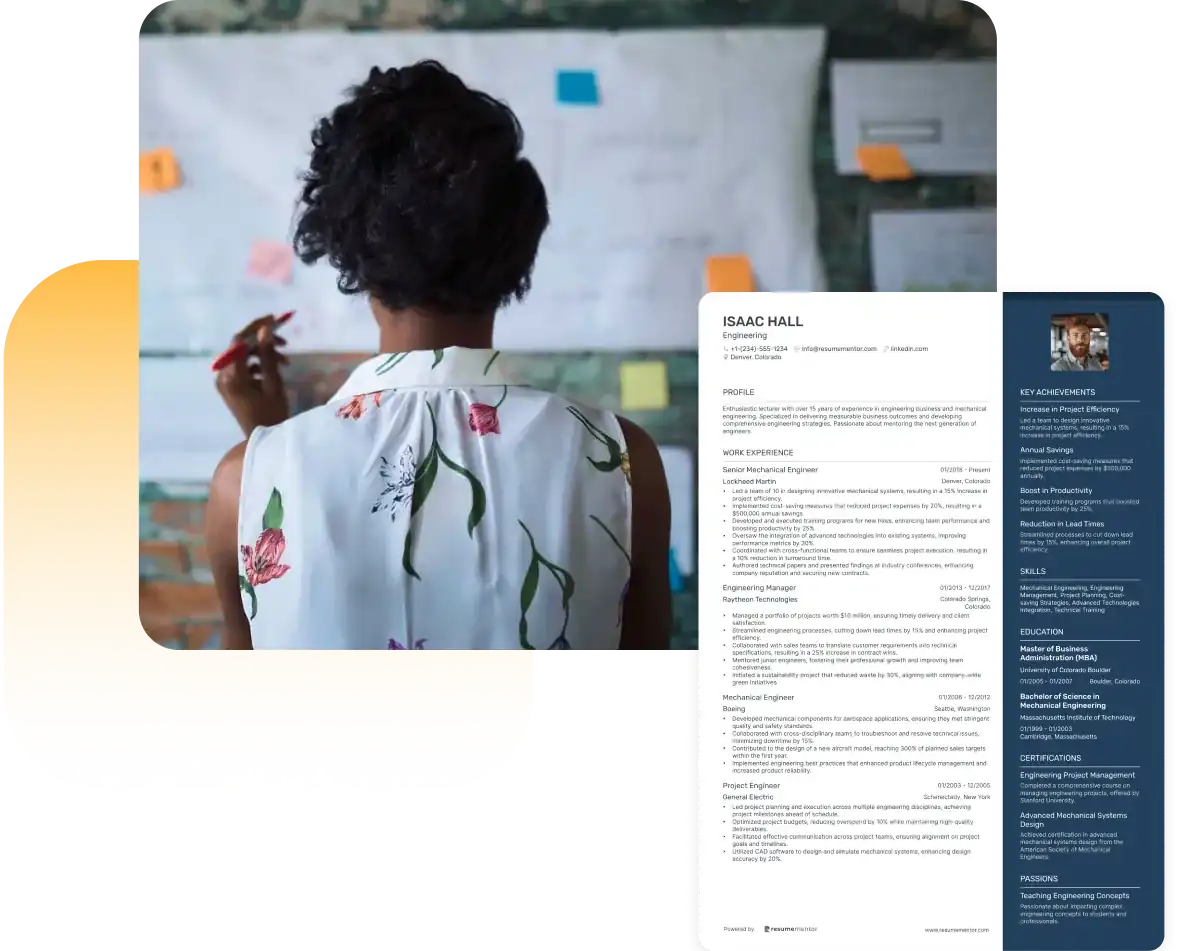
Continue Reading
Check more recommended readings to get the job of your dreams.
Resume
Resources
Tools
© 2025. All rights reserved.
Made with love by people who care.

